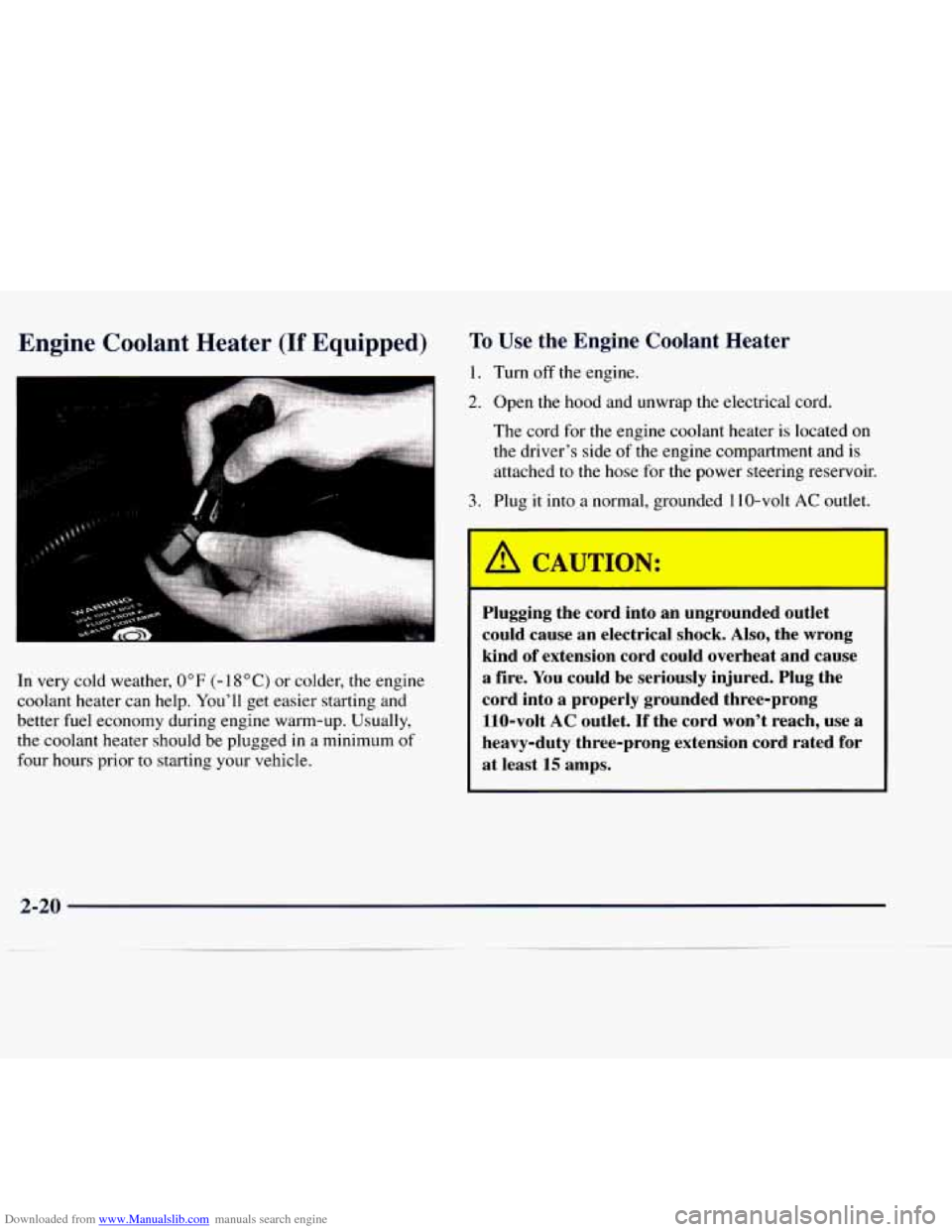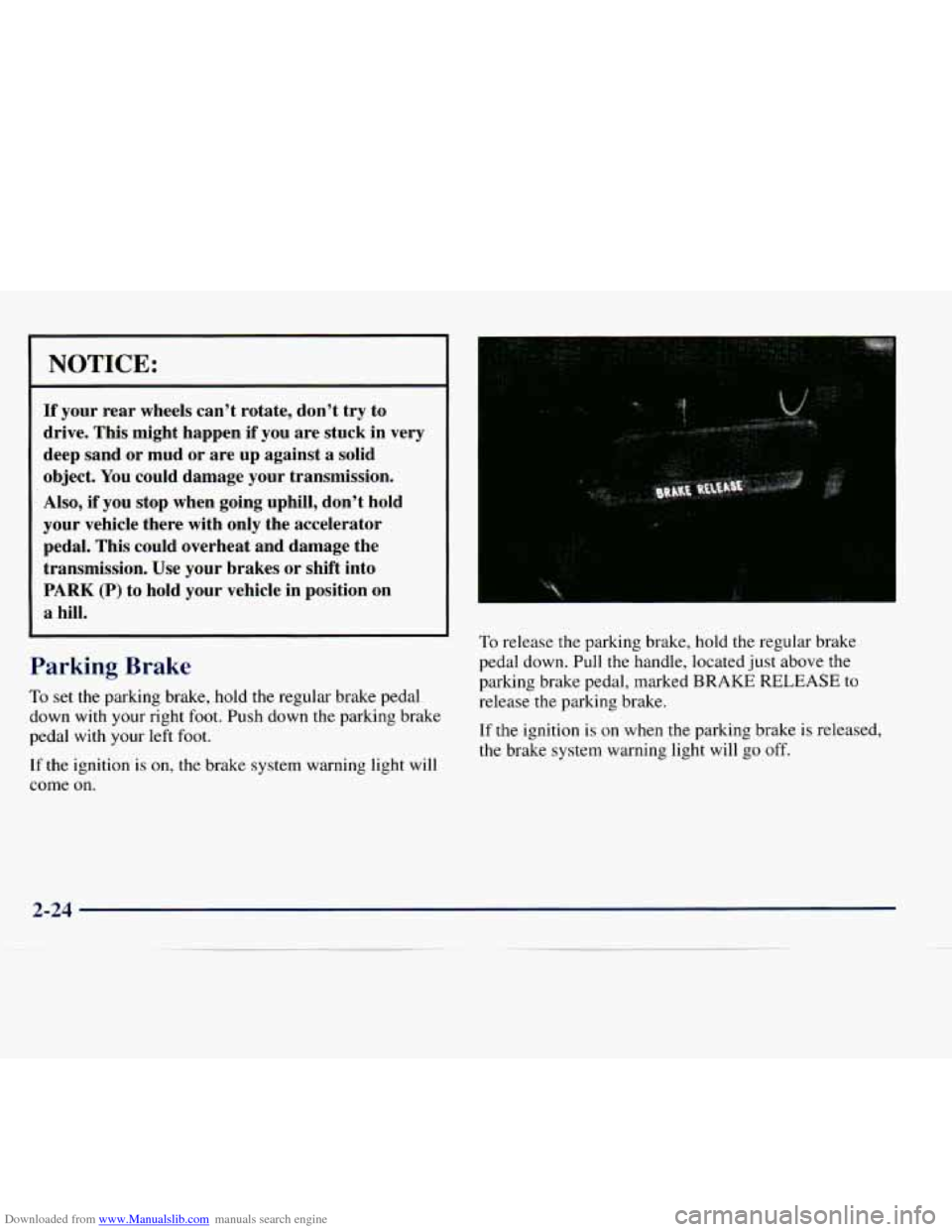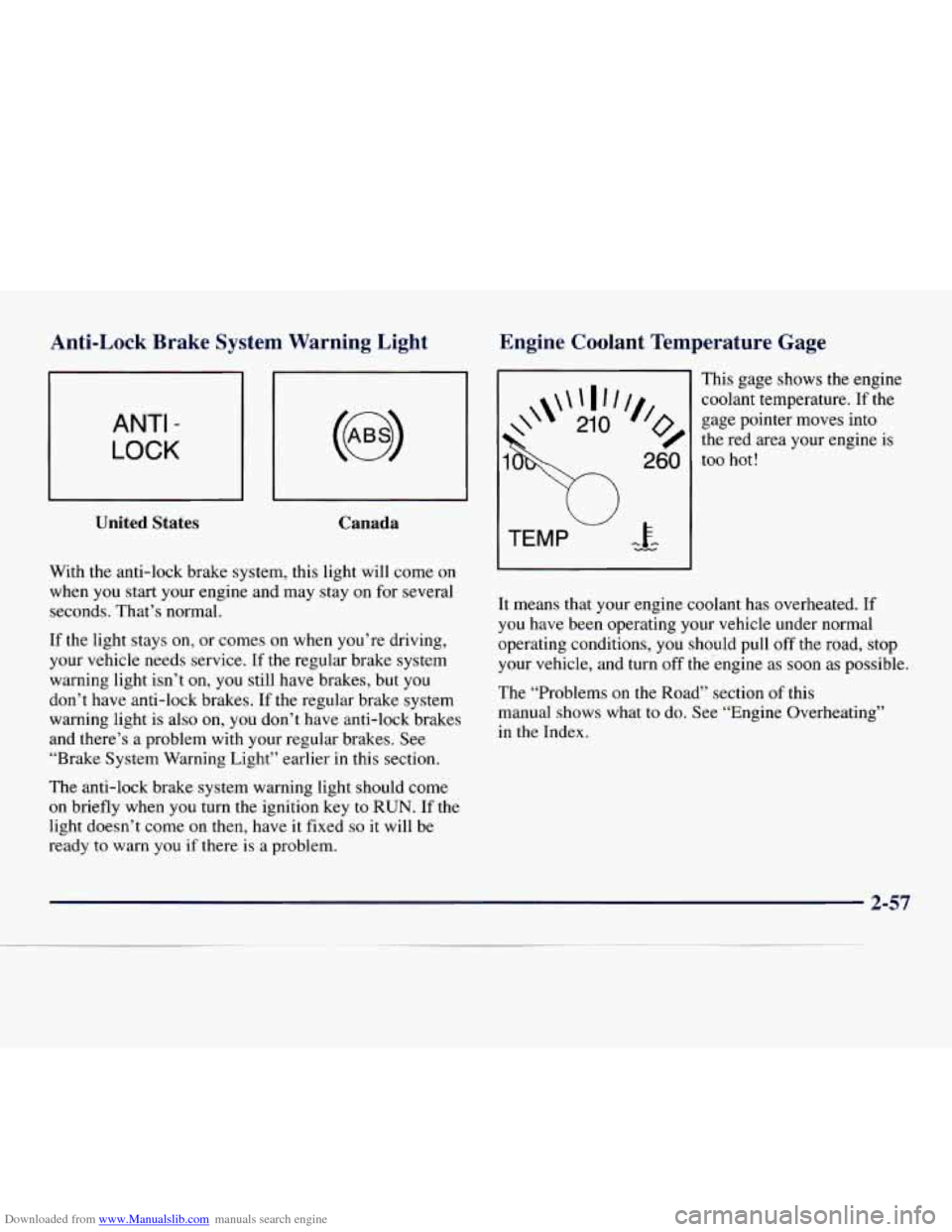1998 CHEVROLET EXPRESS engine overheat
[x] Cancel search: engine overheatPage 2 of 386

Downloaded from www.Manualslib.com manuals search engine The 1998 Chevrolet Express Owner’s Manual
1-1
2-1
3- 1
4-1
5-1
6-1
7-1
8-1
9-1
Seats and Restraint Systems
This section tells you how to use your seats and safety belts properly. It also explains the air bag system.
Features and Controls
This section explains how to start and operate your vehicle.
Comfort Controls and Audio Systems
This section tells you how to adjust the ventilation and comfort controls and how to operate your audio system.
Your Driving and the Road
Here you’ll find helpful information and tips about the road and how to drive under different conditions.
Problems on the Road
This section tells what to do if you have a problem while driving, such as a flat tire or overheated engine, etc.
Service and Appearance Care
Here the manual tells you how to keep your vehicle running properly and looking good.
Maintenance Schedule
This section tells you when to perform vehicle maintenance and what fluids and lubricants to use.
Customer Assistance Information
This section tells you how to contact Chevrolet for assistance and how to get service and owner publications.
It
also gives you information on “Reporting Safety Defects” on page 8- 10.
Index
Here’s an alphabetical listing of almost every subject in this manual. You can use it to quickly find
something you want to read.
i
Page 91 of 386

Downloaded from www.Manualslib.com manuals search engine Engine Cool-nt Heater (If Equipped) To Use the Engine Coolant Heater
1. Turn off the engine. I
2. Open the hood and unwrap the electrical cord.
The cord for the engine coolant heater is located
on
the driver’s side of the engine compartment and is
attached
to the hose for the power steering reservoir.
In very cold weather,
0°F (- I 8OC) or colder, the engine
coolant heater can help. You’ll get easier starting and
better fuel economy during engine warm-up. Usually,
the coolant heater should be plugged in a minimum
of
four hours prior to starting your vehicle.
I
3. Plug it into a normal, grounded 1 IO-volt AC outlet.
1 A
CAUTION:
Plugging the cord into an ungrounded outlet
could cause an electrical
shock. Also, the wrong
kind
of extension cord could overheat and cause
a fire. You could be seriously injured. Plug the
cord into
a properly grounded three-prong
110-volt
AC outlet. If the cord won’t reach, use a
heavy-duty three-prong extension cord rated for
at least 15 amps.
2-20
Page 95 of 386

Downloaded from www.Manualslib.com manuals search engine NOTICE:
If your rear wheels can’t rotate, don’t try to
drive. This might happen if you are stuck in very
deep sand or mud or are up against a solid
object. You could damage your transmission.
Also, if you stop when going uphill, don’t hold
your vehicle there with only the accelerator
pedal. This could overheat and damage the
transmission. Use your brakes or shift into
PARK (P) to hold your vehicle in position on
a hill.
Parking Brake
To set the parking brake, hold the regular brake pedal
down with your right foot. Push down the parking brake
pedal with your left foot.
If the ignition is on, the brake system warning light will
come
on.
To release the parking brake, hold the regular brake
pedal down. Pull the handle, located just above the
parking brake pedal, marked
BRAKE RELEASE to
release
the parking brake.
If the ignition is on when the parking brake
is released,
the brake system warning light will
go off.
2-24
Page 96 of 386

Downloaded from www.Manualslib.com manuals search engine NOTICE:
Driving with the parking brake on can cause your
rear brakes to overheat.
You may have to replace
them, and you could also damage other parts of
your vehicle. Always check to be
sure your parking
brake is fully released before you drive.
If
you are towing a trailer and are parking on any hill,
see “Towing a Trailer” in the Index. That section shows
what to do first to keep the trailer from moving.
It can be dangerous to get out of your vehicle if
the shift lever
is not fully in PARK (P) with the
parking brake firmly set. Your vehicle can roll.
If
you have left the engine running, the vehicle can
move suddenly.
You or others could be injured.
To be sure your vehicle won’t move, even when
you’re on fairly level ground, use the steps that
follow.
If you’re pulling a trailer, see “Towing a
Trailer” in the Index.
1. Hold the brake pedal down with your right foot and
set the parking brake.
Page 98 of 386

Downloaded from www.Manualslib.com manuals search engine Leaving Your Vehicle With the
Engine Running
I A CAUTION:
It can be dangerous to leave your vehicle with the
engine running. Your vehicle could move
suddenly if the shift lever
is not fully in PARK (P)
with the parking brake firmly set. And, if you
leave the vehicle with the engine running, it could
overheat and even catch fire.
You or others could
be injured. Don’t leave your vehicle with the
engine running unless you have to.
Torque Lock
If you are parking on a hill and you don’t shift your
transmission into PARK (P) properly, the weight of the
vehicle may put
too much force on the parking pawl in
the transmission. You may find it difficult to pull the
shift lever out of PARK
(P). This is called “torque lock.”
To prevent torque lock, set the parking brake and then
shift into
PARK (P) properly before you leave the
driver’s seat.
To find out how, see “Shifting Into
PARK (P)” in the Index.
When you are ready
to drive, move the shift lever out of
PARK (P) before you release the parking brake.
If torque
lock does occur, you may need to have another
vehicle push yours
a little uphill to take some of the
pressure from the parking pawl in the transmission,
so
you can pull the shift lever out of PARK (P).
Page 107 of 386

Downloaded from www.Manualslib.com manuals search engine Windshield Wipers
You control the windshield
wipers
by turning the band
with the wiper symbol on it.
For a single wiping cycle, turn the band to MIST. Hold
it there until the wipers start, then let go. The wipers will
stop after one cycle. If you want more cycles, hold the
band on MIST longer.
You can set the wiper speed for a long or short delay
between wipes. This can be very useful in light rain or
snow, Turn the band to choose the delay time. The
closer
to LOW, the shorter the delay.
For steady wiping at low speed, turn the band to the
LOW position. For high-speed wiping, turn the band
further, to
HIGH. To stop the wipers, move the band
to OFF.
Remember that damaged wiper blades may prevent
you from seeing well enough to drive safely. To avoid
damage, be sure to clear ice and snow from the wiper
blades before using them. If they are frozen to the
windshield, carefully loosen
or thaw them. If your
blades do become damaged, get new blades or
blade inserts.
Heavy snow or ice
can overload your wipers. The
windshield wiper motor is protected from overload by a
circuit breaker and a fuse. If the motor overheats due to
heavy snow, etc., the wiper will stop until the motor cools.
Although the circuit is protected from electrical overload,
overload due
to heavy snow, etc. may cause wiper linkage
damage. Always clear ice and heavy snow from the windshield before using your windshield wipers.
2-36
Page 128 of 386

Downloaded from www.Manualslib.com manuals search engine Anti-Lock Brake System Warning Light
ANTI -
LOCK
United States Canada
With the anti-lock brake system, this light will come on
when you start your engine and may stay on for several
seconds. That’s normal.
If the light stays
on, or comes on when you’re driving,
your vehicle needs service. If the regular brake system
warning light isn’t
on, you still have brakes, but you
don’t have anti-lock brakes. If the regular brake system
warning light is also on, you don’t have anti-lock brakes
and there’s a problem with your regular brakes. See
“Brake System Warning Light” earlier in this section.
The anti-lock brake system warning light should come
on briefly when
you turn the ignition key to RUN. If the
light doesn’t come on then, have it fixed
so it will be
ready
to warn you if there is a problem.
Engine Coolant Temperature (I ~ - -:
This gage shows the engine
coolant temperature. If the
gage pointer moves into
the red area your engine is
too hot!
It means that your engine coolant has overheated. If
you have been operating your vehicle under normal
operating conditions,
you should pull off the road, stop
your vehicle, and turn
off the ‘engine as soon as possible.
The “Problems on the Road” section
of this
manual shows what to do. See “Engine Overheating”
in the Index.
2-57
Page 198 of 386

Downloaded from www.Manualslib.com manuals search engine Making Turns
NOTICE:
Making very sharp turns while trailering could
cause the trailer to come in contact with the vehicle. Your vehicle could be damaged. Avoid
making very sharp turns while trailering.
When you’re turning with a trailer, make wider turns than normal.
Do this so your trailer won’t strike soft shoulders,
curbs, road signs, trees or other objects. Avoid jerky or
sudden maneuvers. Signal well in advance.
lhrn Signals When Towing a Trailer
When you tow a trailer, your vehicle has to have extra
wiring and a heavy-duty turn signal flasher (included in
the optional trailering package).
The arrows on your instrument panel will flash
whenever you signal a turn or lane change. Properly
hooked up, the trailer lamps will also flash, telling other
drivers you’re about to turn, change lanes or stop. When
towing
a trailer, the arrows on your instrument
panel will flash for turns even if the bulbs
on the trailer
are burned out. Thus,
you may think drivers behind
you are seeing your signal when they are not. It’s
important to check occasionally
to be sure the trailer
bulbs are still working.
Driving On Grades
Reduce speed and shift to a lower gear before you start
down a long or steep downgrade. If you don’t shift
down, you might have
to use your brakes so much that
they would get hot and no longer work well.
On a long uphill grade, shift down and reduce your
speed
to around 45 mph (70 kdh) to reduce the
possibility of engine and transmission overheating.
When towing at high altitude
on steep uphill grades,
consider the following: Engine coolant will boil at a lower
temperature than
at normal altitudes. If you turn your
engine
off immediately after towing at high altitude on
steep uphill grades, your vehicle may show signs similar
to
engine overheating. To avoid this, let the engine run while
parked (preferably
on level ground) with the automatic
transmission in PARK
(P) for a few minutes before tumine
the engine off. If you do get the overheat warning, see
“Engine Overheating”
in the Index.
4-35